Kofa Refuge
We took a break from the crowds and sights of Quartzsite, and drove down SR-95 to the Kofa Wildlife Refuge. None of us had seen the place, which has multiple access roads to explore. The “we” is Karin, me, and our in-laws Linda and Siegy. This particular foray, on a whim, we elected to take two vehicles – – – which turned out to be a very fortuitous decision.
About 20 miles south of town, Palm Canyon Road cuts off to the east, and we drove up into the area. The scenery is pretty nice, a crisp change to the flat plains between the ridges.

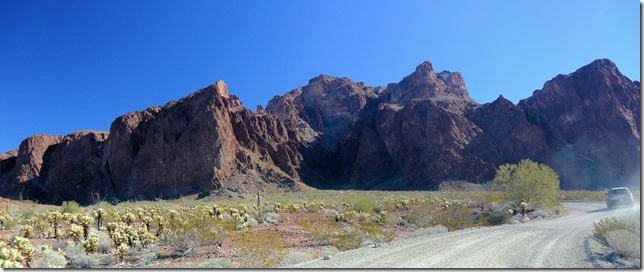
Palm Canyon is named for the plants which find purchase in steep crevices, sipping the run-off moisture from the high crags above the canyon. A trail starts out easy and gets more challenging, including some steep rocky climbs, to go only a half-mile up the canyon. Sure seemed like a lot more – – –
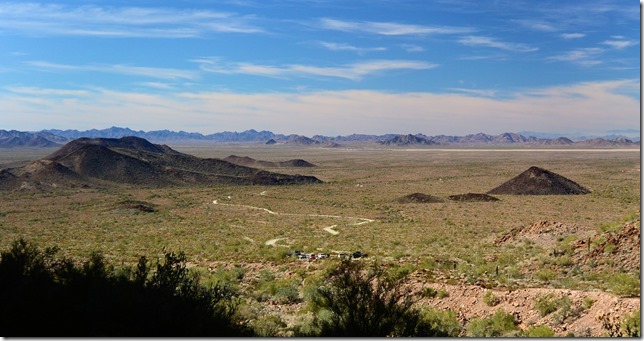
The palms of Palm Canyon are sequestered not in the broad sand washes, where you might think they’d get their moisture. No, instead they are buried in the stark crevices of the fissures along the canyon walls. Despite the lack of sun there (or because of it?), the palms are seeming to thrive, bright green accents to the desert browns and grays.
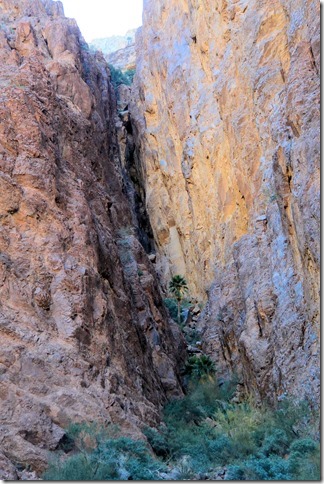
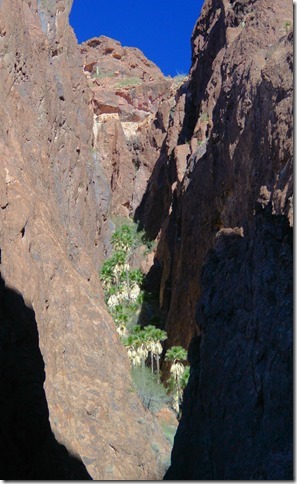
Way up at the end of the official trail, several slightly-worn tracks offered further struggles onward, but we declined more hiking; we lazily sat back on a talus slope and simply admired the beauty around us. With keen eyes (or binoculars), the sights included a far-off band of bighorn sheep, impossibly perched on the vertical rock faces. This curious fellow was probably 300 yards away and not quite straight up.
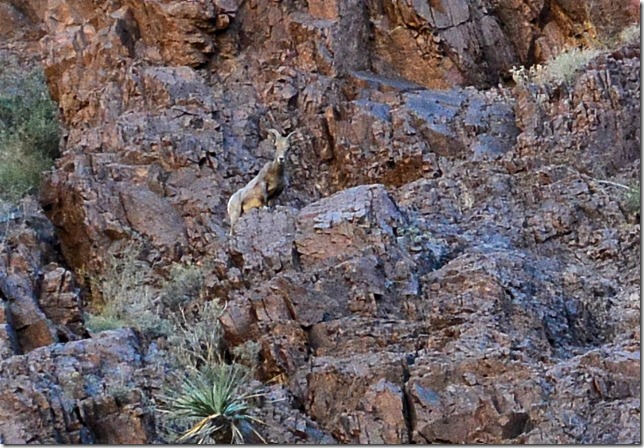
Coming back down the trail was of course easier on the lungs, but the rocky path was tricky footwork in spots. Our shadowed trail seems inky black compared to the sunlit parking lot and distant flats. We reminded ourselves to be extra careful – – – tired muscles and loose footing are a risky combination.
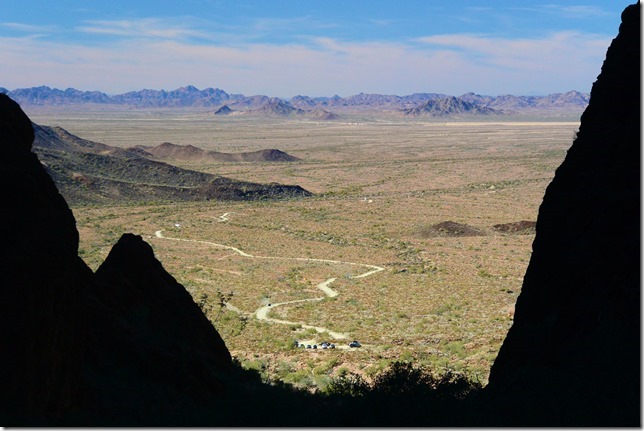
Eventually, we were welcomed back to the parking lot by this cutesy trail marker.
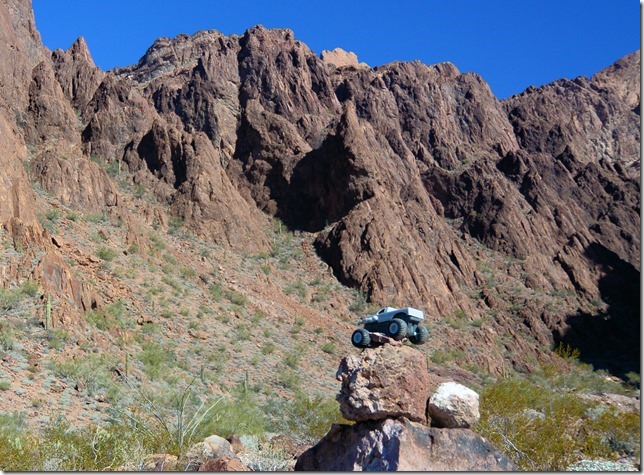
Next, we doubled back to the Kofa Queen road, presumably an old mining access. It heads east again and into another canyon area. This road was decidedly rougher, and pretty much 4×4-only in a few spots. Lots slower but of course a lot more fun. We worked our way several miles back up into the canyons north of Palm Canyon.
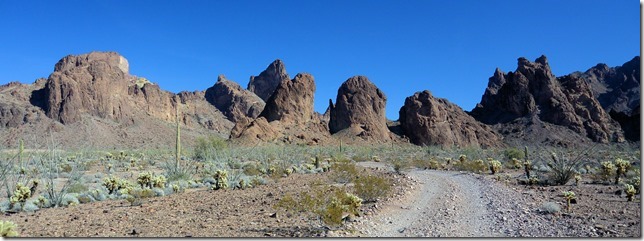
It was getting a bit late in the short winter day, and rather than going the whole 8+ miles back up the canyon, we stopped for a local short hike. The area was a pleasant valley, heavily dotted with cholla and young saguaro cacti. Karin found a big rock to rest on and admire the views.
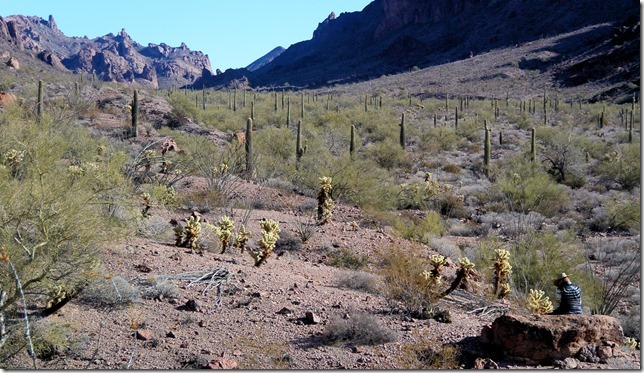
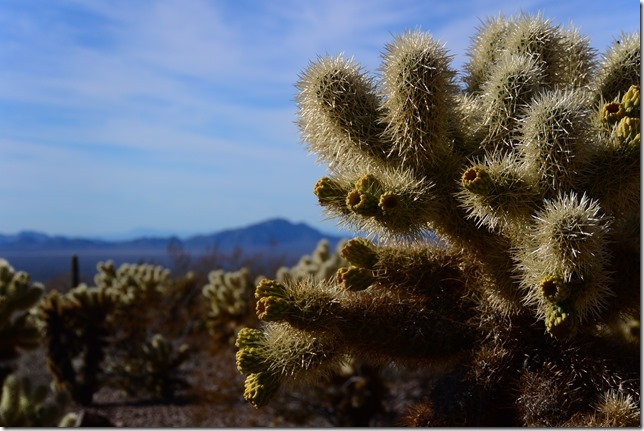
A bright afternoon half-moon rose above the eastern cliffs. It seemed a friendly enough sign, but must have in fact been an omen of the event to come.
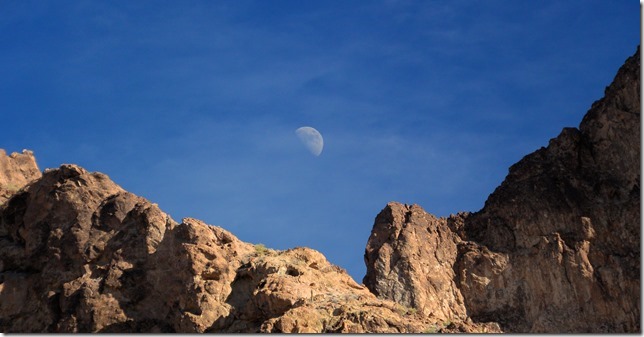
We hadn’t started back for more than a few minutes when Karin’s cell phone rang – – – it was Siegy and Linda telling us to come back and get them. What ??!! The brand-new Jeep Cherokee, 400 miles on it, had gone stone cold dead. No amount of cranking or furrowed brow would bring the engine to life. It being a computer-controlled car, we tried to “re-boot” it by running through all the shifting and starting sequences. Nope, no luck at all.
Out came Ralph’s old-reliable tow strap, and in a few minutes we were hooked up to the Jeep. Siegy had his hands full (feet too) with non-power steering and brakes. But the stretchy nylon strap did what it was designed to, and there was no damage to any chassis or body work. We just lurched and yanked ourselves back down eight or nine miles of dirt track until we were able to park the Jeep next to the highway.
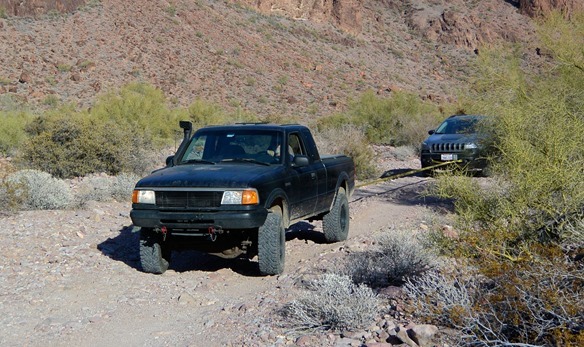
Turns out, the only way that Roadside Assistance could have pulled the Jeep out of that remote canyon would have been with a specialized 4×4 tow vehicle. And they’re in such short supply and high demand that it would have taken another day to get up there. So it was really good that we had a way to get the Jeep back to the highway (towed by Ralph). And we were all extremely happy that a.) we had decided to take two vehicles, and b.) that we all four didn’t have to spend the night in a VERY cold Jeep in the high desert. No food, no tent, no blankets or sleeping bags.
As it was, the whole event was pretty benign. The Jeep got picked up by a tow truck and Siegy and Linda were dropped off near camp. The next day, all four of us crammed into Ralph a few times (he has rear jump seats in the extended cab), and we continued with the Show and shopping and such. So overall, it was no big deal – – – this time. But it really made us all think hard about how to deal with a more dire emergency. What if there were no second vehicle, no cell phone coverage – – – what then? We are going to carefully inventory our “survival kits” to make sure we’re more prepared for a worse eventuality than this one.
EPILOG: The Jeep went to a service center in Blythe, where they couldn’t fix it. Then it got towed (again) to a Jeep/Chrysler dealer in Blythe, and we’re all still waiting for the verdict. Siegy and I have casual guesses about broken wires, failed components, etc. But no data yet.
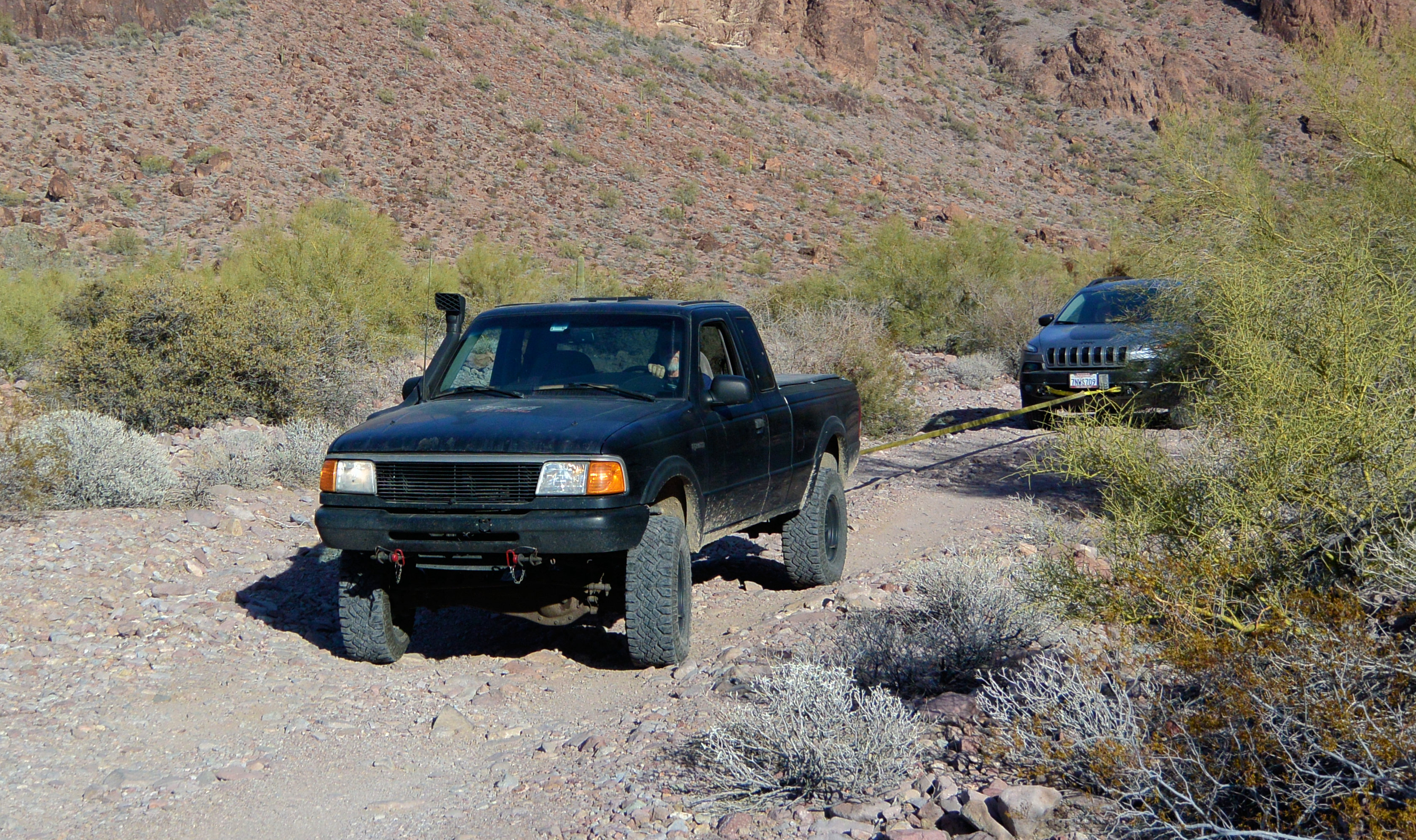
Greg … You sure get into some interesting situations. It seems you have a way and knowledge to get through about anything you get into … Especially when you were on your Alaska trip!
Jim
Jim, so far, so good (fingers crossed, knock wood, silent prayers).
:o)
The curse of the computer vehicle. On my way to court one morning my 2008 Sierra gave up the ghost on I-8. AAA tow to the GMC dealer to found out it was the electronic fly-by-wire foot throttle. $350 later I was good to go.
But what If it happened on a dirt road in Baja?
Then at 95,000 miles, the #7 lifter on my Active Fuel Management (AFM) equipped 6 L 4×4 died, leaving me with $4500 worth of engine work. Three months later it happended again, this time on GMC’s dime.
Point is these new government designed enginees may minimize smog but they are unreliable for remote off-road travel. Now I only take my 1990 Bronco off road. It’s basic enough to fix if it breaks. I also travel with a buddy as often as possible. And perhaps my greatest buddy is my SPOT device which I can use to call for help.
Willie, I couldn’t agree more. My personal “go there AND get back” vehicle is Ralph, my ’96 Ranger 4×4. A simple engine PCU (computer), individual cylinder spark coils, injectors. All else mechanical. And all that said, Ralph has a new engine due to persistent coolant leaks into the combustion chambers. Bottom line is that mechanical/electric things WILL fail. Like you, my best buddy is my InReach. It’s a lot like the Spot, but it uses the Iridium network and can send/receive texts and emails. A second vehicle sure makes for easy recoveries – – but we rarely have that option.
Trek safe,
G.
I’ve tought about the InReach. Do you like it? It seems like the monthly cost is subtantially more than my SPOT. I pay something like $150/year.
The wife and I are going to do a week of kayak camping on Lake Powell in May. I thought about the InReach, but the change from SPOT has to be compelling enough to justify.
I can pre-program in messages on SPOT. Mostly I use only one message that says to loved ones, “Starting or stopping for the day”. And of course the cookie crums feature keeps people informed on where we are and the 911 function is really really important to my mental well beingl.
I am very pleased with the InReach, which costs me $25/mo ($300/yr). First, it’s on Iridium, which is more reliable than the Glonass (no dropped messages). Second, it is actually capable of back-and-forth communication via texts. I’ve used this MANY times, even once for an essential financial communication. Saved me from having to come out of the back country to deal with it. And yes, it’s also got the tracking and a shared-map feature, SOS capability, etc.
A little pricey, true, but worth it to me.